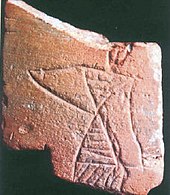Gaṇikā
Appearance

Gaṇikā or ganika (
Ancient India
known as ganikas were prominent in city life.
In early India, the word "ganika" referred to a courtesan or public dancer, though the word was occasionally also used for prostitutes.[1][2]
Ganikas were trained in fine arts like dance and music in order to entertain
princes, and other wealthy patrons on religious and social occasions.[3] A woman would earn the title of "Ganika" if, alongside being seen as beautiful, she became versed in the 64 parts of Kalā. This title also granted a seat of honour in an assemblage of men.[4]When a Ganika lives with her lover, she maintains the relationship like a wife.[5]
References
- ^ "Mujra, a misunderstood concept". www.esamskriti.com. Retrieved 2023-12-20.
- ^ www.wisdomlib.org (2014-08-03). "Ganika, Gaṇika, Gaṇikā: 28 definitions". www.wisdomlib.org. Retrieved 2023-12-20.
- ^ "The Ganika in Buddhist and Jaina literature". INDIAN CULTURE. Retrieved 2023-12-20.
- ^ "The Kama Sutra of Vatsyayana: Part I: Introductory: Chapter III. On the Study of the Sixty-Four Arts". sacred-texts.com. Retrieved 2023-12-20.
- ^ "CHAPTER II OF LIVING LIKE A WIFE".
